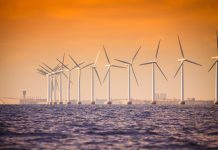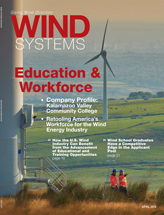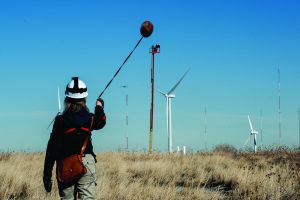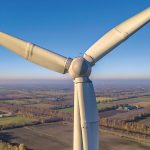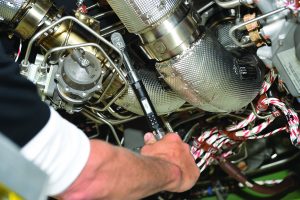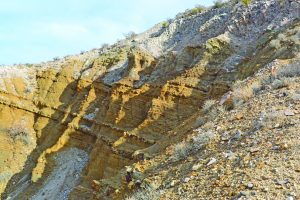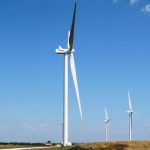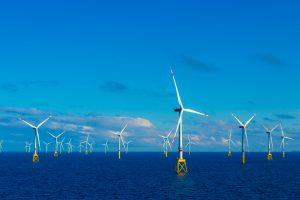Makani doesn’t make a typical steel wind turbine tower, such as GE’s widely used 1.5-MW model that consists of 116-foot blades on top of a 212-foot tower for a total of 328 feet from the base to the nacelle. Founded in 2006, the Almeda, California-based company made a name for itself in the wind industry by developing a low-cost renewable energy solution using kite technology to generate electricity.
An energy kite is a plane-like device with rotors that flies around like a kite. Its system is made up of four parts: the kite, the tether, the ground station, and the computer station. The rotors lift the kite off the ground, but once it’s in flight, the kite generates power by flying in large circles where the wind is strong and consistent. The wind allows the rotors to work as individual turbines, and the energy created powers an onboard generator that sends the generated energy down the tether to the grid.
In 2013, Makani was acquired by X, Google’s research and development facility that’s operated by Alphabet Inc. and develops advanced technologies. According to Fort Felker, the general manager for Makani at X, the company has made a lot of progress since joining X, including improving how the kites launch and land, how they fly in variable wind conditions, and how to generate power more efficiently.

“Our new energy kite will reach higher, fly longer, and generate 30 times more power than earlier versions,” Felker said. “We’re moving from our proof-of-concept phase to a stage where we want to test ourselves against the real-world challenges we’ll face if we want to bring electricity to people.”
According to Felker, Makani was inspired by an idea conceived in 1979 that was only recently made possible because of technological advancements.
“Carbon fiber — the material we use for parts of our kite and tether — has become stronger, lighter, and cheaper, which has made it physically possible to fly a small kite in strong winds,” Felker said. “Also, Moore’s law has made computers smaller and more powerful, making it possible to direct the path of the kite for optimal energy generation using a flight computer that is now about the same size as a smartphone.”
These breakthroughs have allowed Makani to replace tons of steel and concrete with smart software and advanced materials.
“Makani’s kite actually operates on the same aerodynamic principles as a conventional wind turbine, but is able to replace tons of steel with lightweight electronics and smart software,” Felker said. “By building just the tip of a wind turbine blade, which makes most of the energy, and replacing the rest of the structure with a computer system and more advanced materials, and without a tower holding them in place, energy kites eliminate 90 percent of the materials of conventional wind turbines. Because the kites are more aerodynamic and able to access stronger, more consistent wind at higher altitudes, we think they’ll be able to generate 50 percent more energy. The lower cost and higher energy output more than quadruples the amount of land available in the U.S. for wind energy production.”
Also, because the energy kite is lightweight, it can fly at high altitudes, allowing it to access stronger, steadier winds and generate more clean energy. Its tether is made up of conductive wires that connect the kite to the ground station where the kite is parked when it’s not flying. The computer station combines GPS, sensors, and other advanced technologies to guide the kite in the flight path that will allow it to maximize the amount of energy it generates.

“Conventional wind turbines must be sited in locations where the wind is fast and consistent enough to generate enough power to offset costs, but less than 15 percent of all land around the world is suitable,” Felker said. “Energy kites, on the other hand, can be economically sited in a wide array of locations, including sites that are too remote from roads, too hilly, or not windy enough for conventional turbines. In the continental United States alone, energy kites could generate wind power economically in over two-thirds of the landmass, more than four times the area available to conventional wind turbines.”
As a part of X, Makani is focused on creating a “moonshot,” which is Google’s catchall description for innovations that could revolutionize the world. According to Felker, there are three factors that constitute a moonshot: one, if it is a big problem for the world, in this case, turning wind into a viable, clean source of renewable energy. Second, you need breakthrough technology, and Makani’s technology certainly meets that criterion as it could dramatically change the calculus of wind power.
“Its technology reduces the cost and complexity of harvesting wind,” Felker said. “It moves us from an industrial-era solution involving tons of steel and open space to a control systems problem involving sensors and smart software.”
Lastly, there needs to be proof that the moonshot is viable. Makani has done so by logging more than 100 hours of flying time generating power.
Makani is one of many successful X endeavors, including Google Glass, high-altitude Wi-Fi balloons, and driverless cars. More recently, the company has been developing the latest version of the energy kite that can fly higher, last longer, and generate more energy than earlier versions — up to 30 times the power for kites that are three times the size of the current prototypes.
“We’ve incorporated redundancy for extra safety and reliability, including three flight computers instead of one, more rotors to keep the kite flying in case one breaks, and backup communications,” Felker said. “We have also improved the durability of the system so that it can handle more variable weather conditions and last for years. We’re ready to take the final steps toward providing electricity to people in the real world, which means moving from proof-of-concept to flying in real-world conditions. We’ve started working on a pilot project in Hawaii to test long-duration flights of the kite for the first time so we can learn as much as possible and feed it back to the design process, including what our power curve is and how to efficiently maintain the kite over long periods of time.”
In May 2015, Makani began testing an 84-foot-long model that can generate up to 600 kW of energy. Prior to that, its kite models were only 28 feet in length.
Despite the company’s progress, Makani is still in the early stages of developing its kite systems. However, Felker said they’re on the right track to making their energy kites commercially available.
“It’s still early days for Makani, and we have a lot to learn about the technology and what it would take to make renewable energy more accessible,” Felker said. “We’re in favor of measures like the PTC extension that make the market more stable and could help us as a society realize the benefits of many kinds of renewable energy sooner.”
For more information, go to www.google.com/makani.

















